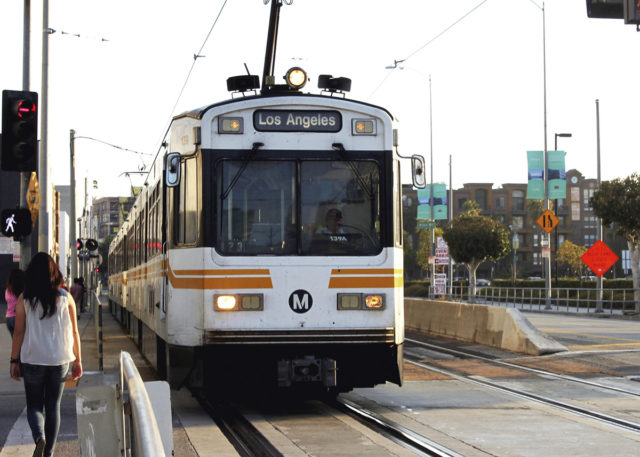The Los Angeles Metro held two public scoping meetings in January to gather public input on its Sepulveda Transit Corridor Project, which aims to create rapid transit options connecting the San Fernando Valley and the Westside.
The project is currently in scoping, a stage of environmental review where public participation and input are encouraged.
The meetings on Jan. 11 and Saturday began with Metro community relations officer Matthew Marquez polling attendees about their area of residence and prior experience with the Metro. Most attendees responded that they were from the San Fernando Valley and the Westside.
Planning for the Sepulveda Transit Corridor Project began in 2019, when Metro conducted a feasibility study to research potential routes for public transit connecting the San Fernando Valley and LAX.
In March 2021, the Metro Board approved pre-development agreements with LA SkyRail Express and Sepulveda Transit Corridor Partners, a group of firms led by Bechtel Infrastructure, to draw plans for the project and research solutions for construction across mountainous terrain, according to press releases by the contractors.
Currently, there are six project proposals, called alternatives, being analyzed and one no project alternative, which would direct Metro to focus on other transit and freeway projects through 2045 without a Sepulveda Pass project. The first three project alternatives are aerial monorail proposals, and another three project alternatives are partially or entirely underground rail. Only the rail project alternatives currently include planning for stops at UCLA.
Members of the public gave comments about their opinions of the project alternatives.
Andrew Lewis, the vice president of the North Westwood Neighborhood Council, which represents UCLA and its surrounding areas, said he supports alternatives five and six.
“Options one and two and anything that includes the monorail should not be considered seriously, should be scrapped and would be a complete waste of money,” Lewis said. “Further, we’d like to call on Metro to explore feasibility for first/last mile options after the route is chosen to connect to the Purple Line Extension on Wilshire (Boulevard) so that folks can seamlessly connect once they get to Westside to that line later on.”
Furkan Yalcin, the NWWNC president, said he thinks the most important part of the Sepulveda Transit Corridor Project would be a Metro stop located directly on the UCLA campus.
Yalcin added that since Westwood rent prices have risen dramatically over the years, many people have to commute to Westwood for work and school from neighboring areas.
“If we want to make sure that they can commute to UCLA in an environmentally friendly way, an easy way, and accessible way, that there (needs to) be as little limitations as possible for them to get to UCLA,” Yalcin said. “That means not having an option with a people mover or a bus transfer. It has to stop on the campus.”
Sachi Cooper, a NWWNC undergraduate student member and a co-chair of the NWWNC Planning and Land Use Committee, believes that Metro should not consider proposals without a stop at UCLA and Westwood.
“It should be clear by now that a UCLA and Westwood Village stop are essential for students, faculty, staff, medical patients, visitors, sports fans, museumgoers, and more,” she said. “Students are fighting for this because we know that it is the right thing to do to improve access and equity for all Angelenos.”
Some members of the public expressed their concern over the need for extensive tunneling under the Santa Monica Mountains and residential areas under the underground rail alternatives.
“I am concerned about this tunneling under our area,” said Diane Fisk, a member of the Bel-Air Association. “I wonder if anybody is considering the huge cost of the tunneling under these mountains versus the monorail on the Sepulveda Pass. A monorail seems to me would be a very modern looking option, and I think it would be considered to enhance our aesthetics.”
Michael Rich, a Bel Air resident, said he thinks tunneling may result in heavy shaking, caused by the operation of underground rail and the use of explosives in tunneling, which may impact stability and quality of life for residents.
“I realize that the interests of the millions of people in this city sometimes have to take precedent, but I really worry about the potential to destroy the value of our homes, to destroy the peace of our landscape, to really, essentially take away our homes without having proper compensation or a voice,” Rich said.
Several individuals from Sherman Oaks expressed concerns with alternative four, which includes an elevated section of the heavy rail train running above Sepulveda Boulevard and they said may be detrimental to quality of life in Sherman Oaks.
Peter Kearns, a Westwood resident, said he has reservations about the monorail options and the company involved in constructing the monorail, BYD USA, adding that there were performance and mechanical problems with the electric buses BYD was contracted to supply to LA Metro.
Metro is gathering public comment on the Sepulveda Transit Corridor Project through their online comment form, email, phone and mail until Feb. 11.

